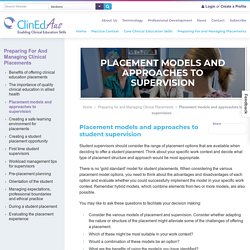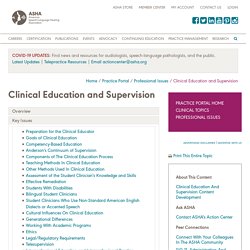

Placement Models and Approaches to Supervision - ClinEdAus. Placement models and approaches to supervision in clinical education Clinical educators need to consider the range of placement options that are available when deciding to offer a clinical education placement.

You need to think about your specific work context and decide what type of placement structure and approach is most appropriate. Clinical education placements can vary in a number of ways including: (Mental Health Coordinating Council, 2013, p.14) These variables are reflected in the different models of clinical education placements that are currently used in allied health. There have been few comparative studies of the effectiveness of different models. Back to Top Traditional model Also known as: one-to-one placement; apprenticeship model; mentorship; role-established placement Key characteristics: Useful references: Lekkas et al. (2007); Sheepway, Lincoln & Togher (2011) Back to top Collaborative model Multiple mentoring. School of Communication Sciences and Disorders. To assist Clinical Educators (CEs) in providing students with high quality practicum experiences we have developed a range of resources.

Jump to: Obtaining Professional Associate Status with McGill University Please contact lili.saran@mcgill.ca if you wish to enquire about obtaining Professional Affiliate status with McGill University. Strategies for Clinical Teaching Joanne E. Schupbach Practice Management and Professional Issues Professional Issues 6944. Editor's note: This text-based course is a written transcript of the live seminar, "Strategies for Clinical Teaching," presented by Joanne Schupbach, M.S., M.A., Manager Audiology Clinical Education, Assistant Professor, Rush University Medical Center.

The course handout is available here (PDF) - it is recommended to download the course handout prior to reading the text course. In my role here at the university, my interests have focused on clinical education including clinical teaching, supervision and mentorship. Today I would like to share some information with you regarding what makes a positive learning environment and specific strategies that can be used in clinical teaching. Rush University is a multidisciplinary health care institution. Much of what I have learned about clinical teaching has come from evidence in other areas of health care including nursing, physical therapy, occupational therapy, and medicine. Clinical Teaching Goals This is quite a mandate for all of us. The Collaborative Approach To Clinical Education. McCrea Excerpt Chap2.
Supervision Tips Final revised July2019. McCrea Excerpt Chap4. Cultural Competence: Key Issues. Roles and Responsibilities Professional competence requires that audiologists and SLPs practice in a manner that considers the impact of cultural variables as well as language exposure and acquisition on their clients/patients and their family. ASHA-certified practitioners have met rigorous academic and professional standards, including knowledge of cultural variables and how they may influence communication. See ASHA's Scopes of Practice in Audiology and Speech Language Pathology as well as Audiology Certification Standards and Speech-Language Pathology Certification Standards. Clinicians are responsible for providing competent services, including cultural responsiveness to clients/patients/families during all clinical interaction. Responsiveness to the cultural and linguistic differences that affect identification, assessment, treatment, and management includes the following: Ethical Considerations Developing Cultural Competence Developing cultural competence is an ongoing process.
Issues in Ethics: Supervision of Student Clinicians. About This Document Published 2017. This Issues in Ethics statement is a revision of Supervision of Student Clinicians (originally published in 2003 and revised in 2010). It has been updated to make any references to the Code of Ethics consistent with the Code of Ethics (2016). The Board of Ethics reviews Issues in Ethics statements periodically to ensure that they meet the needs of the professions and are consistent with ASHA policies.
Issues in Ethics Statements: Definition From time to time, the Board of Ethics (hereinafter, the "Board") determines that members and certificate holders can benefit from additional analysis and instruction concerning a specific issue of ethical conduct. Introduction. Knowledge and Skills Needed by Speech-Language Pathologists Providing Clinical Supervision.
Ad Hoc Committee on Supervision in Speech-Language Pathology About this Document This knowledge and skills document is an official statement of the American Speech-Language-Hearing Association (ASHA). This knowledge and skills statement was developed by the Ad Hoc Committee on Supervision. Members of the committee were Lisa O'Connor (chair), Christine Baron, Thalia Coleman, Barbara Conrad, Wren Newman, Kathy Panther, and Janet E. Brown (ex officio). CAPCSD_10GenericAbilities from ETLO on Vimeo. Alarcon Building a Foundation of Excellence. Clinical Education and Supervision: Key Issues. Preparation for the Clinical Educator According to the ASHA Ad Hoc Committee on Supervision's Final Report on Knowledge, Skills and Training Consideration for Individuals Serving as Supervisors [PDF] (ASHA, 2013c): A prevailing philosophy suggests that competency in clinical service delivery translates into effective clinical supervision.

However, leaders in education have long argued that this is a flawed assumption and that effective supervision requires a unique set of knowledge and skills. The Ad Hoc Committee acknowledges that supervision is a distinct area of practice and, as in other distinct areas, individuals must receive training to gain competence before engaging in the activity. Education in the supervisory process should begin early, with—as a minimum—an introduction to the subject as part of the graduate curriculum and more extensive training readily available to practicing and aspiring supervisors. Bubbl.us CAPCSD Tutorial. - Better reading and research with annotation, highlighter, sticky notes, archiving, bookmarking & more. Diigo V3: Highlight & Share the Web! Social Bookmarking 2.0. Council for the Accreditation of Educator Preparation.
The American Academy of Audiology is the world's largest professional organization of, by, and for audiologists. American Speech-Language-Hearing Association. Home - Council of Academic Programs in Communication Sciences.